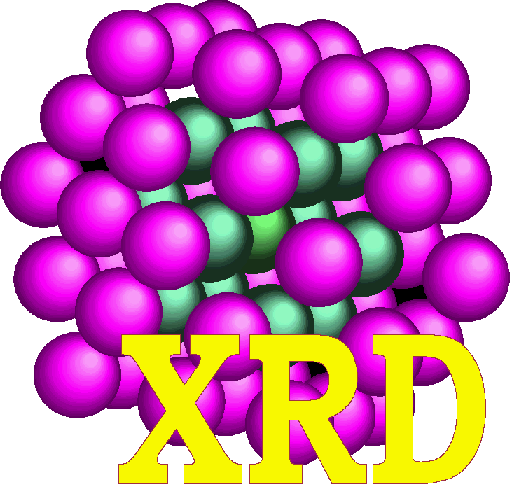Research
Development of nanocrystallography
Nanocrystallography
Powder diffraction has been developed as a phenomenological science based on perfect crystallography but with a lot of formal assumptions that could not be verified on a precise atomistic model due to complexity involved. This applies to analysis of diffraction peak broadening i.e. Scherrer formula, Williamson-Hall analysis, Debye-Waller effect etc. Approaching small nanostructures the atomistic models become now possible and all the PXRD methodology can be verified ab initio using basic for diffraction Debye formula and even not assuming Bragg's law. This ab initio analysis reveals that Bragg's law for small nanocrystals is no longer precisely obeyed and that peak position no longer points to the real interatomic distance. This was proved and pointed to in a series of our papers since 2001.
However the atomistic models are not often used nor the Debye summation formula for diffraction pattern calculation. Most papers, interesting on the obtained material side, discuss structure of even small nanoparticles with no proper account on their natural feature - violating Bragg's law causing small shifts of peak positions even for perfect lattice with no strain. The Debye formula calculated patterns for a simple fragments of perfect lattice can easily reveal that various peaks point to different lattice parameter and that Bragg's law points to interlayer distance different than assumed for the model fragment. For larger particles (>10nm) this effect may be difficult to notice. This is why diffraction studies of nanoparticles has to be divided between larger nanoparticles (D> 10-20 nm) and smaller ones. To the first class most of the classic powder diffraction techniques applies including Rietveld refinement with all the phenomenological treatment of strain, texture, Debye-Waller effect, vacancies etc.
For the second class of materials its lattice parameter often depends on size, the Bragg's law is inaccurate, the strain may have significant surface oriented component, the polymorphism may be size driven, the thermal effect may be more complex due to surface atoms oscillation, there may be noticeable effects of surface reconstruction, larger thermal fluctuations leading to partial amorphisation, concentration gradients caused by segregation etc. These interesting phenomena can be tackled by diffraction but e.g. Rietveld method is here of limited use. Most published papers shows no creativity in this respect but stubbornly applies the textbook methodology and tries to apply classic polycrystalline methods without checking on the models.
The research method of our choice to address the above mentioned structural problems is in situ powder diffraction focused on analysis of dynamics of a very small changes in diffraction peaks position, intensity and width. This way one can follow subtle transitions of metal nanocrystals surface ocuring in response to a chemical process at the surface (e.g. adsorption or reaction).
Due to systematic errors the measurment accuracy is as a rule much lower than the precission and repeatability. Analysing evolution one deals with differences of quantities for which most of experimental errors is the same so they vanish on subtraction. Accuracy of the evolution is thus much better than that of a single measurement and nearly equal to experimental precission.
This allows detection of a subtle changes interpreted by atomistic simulations in terms of a nanocrystal surface changes.
The proposed methods and tools are mostly new to crystallography but address the most sensitive questions of nanocrystallography.
A popular definition of nanocrystallography is - a branch of science applying methods of crystallography to nanocrystals. This definition already does not apply to novel methods of electron nanocrystallography or femtosecond nanocrystallography that address studies of atomic and molecular arrangements in a scale of nanometers but using methods and tools not used previously. It becomes now apparent that structural studies of small nanocrystals of size below 10 nm rise specific questions and require specific methods. With measurable effects of surface relaxation and reconstruction that can be chemically induced the classic tools like Bragg's law, Rietveld refinement, strain analysis etc. are not well applicable. Developed by us for in situ powder diffraction a method to monitor and interpret changes to nanocrystal surface structure allows detection of a chemically induced surface reconstruction as well as observations of surface induced symmetry violations and nanocrystal reshaping. As most of
crystallographic rules for small nanocrystals is no longer strictly obeyed, the proposed method builds up new tools of 'true nanocrystallography' basing on atomistic simulations.
After our successful first observation of dynamics of Pt surface reconstruction [1] on hydrogen desorption we were able to measure a degree of surface relaxation (affecting the overall interplanar spacing) on adsorption and relate it to the adsorption energy and the coverage. The observation of changing on adsorption interplanar spacing much exceeding the change expected from adsorption energy and coverage, is indicative of a lateral surface reconstruction phenomenon [2]. Such a tool allowed us to propose an explanation of the observed quick coalescence of Pt in NO atmosphere at 80 deg.C, in terms of a turbulence caused by a self-canceling cyclic surface reconstruction, the reconstruction being detected by our method [3]. The cyclic phenomenon would be caused by a changing on reconstruction number of the atoms exposed to the adsorbate. The caused surface turbulence forms a likely driving force for a nanocluster transport and merger.
The developed tools allows also e.g. explanation and control of the reversible surface segregation phenomena in PdAg nanoalloy giving insight into elementary diffusion mechanisms [4].
This novel nanocrystallography can be well applied to nanocrystals under pressure overcoming known in catalysis so called pressure gap and material gap.
1. Rzeszotarski P., Kaszkur Z., Phys.Chem.Chem.Phys., 11, 5416 – 5421 (2009).
2. Kaszkur Z., Rzeszotarski P., Juszczyk W., J.Appl.Crystallogr., (2014), 47, 2069-2077.
3. Kaszkur Z., Mierzwa B., Juszczyk W., Rzeszotarski P., Łomot D., RSC Adv., 4 (28), 14758 – 14765 (2014) .
4. Kaszkur Z., Juszczyk W., Łomot D., Phys.Chem.Chem.Phys., (2015), under review.



